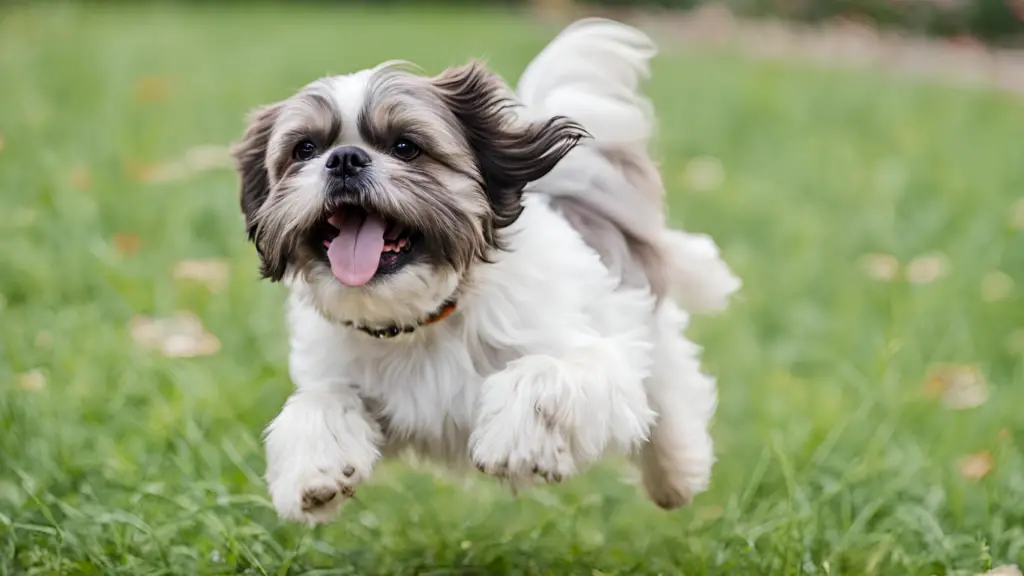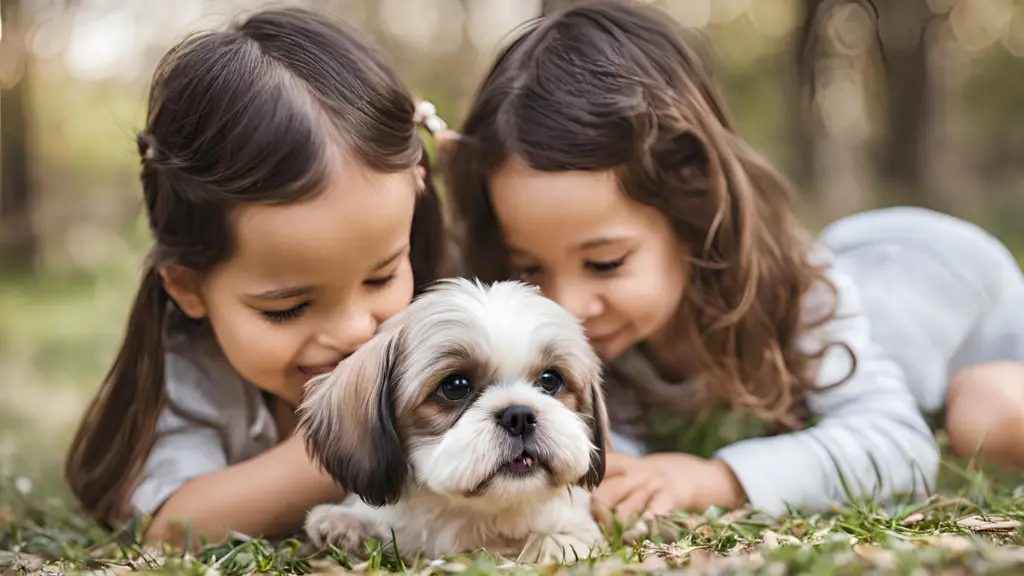
Understanding your Shih Tzu’s behavior can be like learning a new language. These charming little dogs have a unique way of communicating their needs, desires, and emotions. By decoding their behaviors, you can strengthen your bond and ensure that your Shih Tzu is happy and well-cared for. This guide will help you unravel the mysteries of your Shih Tzu’s secret language and provide insights into their various behaviors.
Understanding Shih Tzu Body Language

Tail Wagging: A Sign of Happiness
Tail wagging is a common way Shih Tzus express their emotions. A wagging tail typically indicates happiness or excitement. However, the speed and position of the tail can provide additional clues about their feelings. A fast wagging tail usually signifies excitement or eagerness, while a slow wag might indicate uncertainty or caution.
Key tail positions include:
- High Tail Wagging: When your Shih Tzu holds their tail high and wags it quickly, it’s a sign of enthusiasm or happiness.
- Low Tail Wagging: A low, slow wag can indicate submission or a lack of confidence.
- Tail Tucked: A tail tucked between the legs often signals fear or discomfort.

Ears and Eye Contact: Gauging Emotions
The position of your Shih Tzu’s ears and their eye contact can reveal a lot about their emotions. Ears that are perked up usually indicate curiosity or attentiveness, while ears pulled back against the head may signal fear or submission. Eye contact is another important aspect of communication; direct eye contact often shows trust and affection, while avoiding eye contact might indicate anxiety or discomfort.
Important ear and eye contact signals include:
- Perked Ears: Indicates interest, curiosity, or attentiveness.
- Back Ears: Suggests fear, submission, or discomfort.
- Direct Eye Contact: Shows trust and affection.
- Avoiding Eye Contact: Can indicate anxiety or fear.

Posture and Movement: Interpreting Stance
Your Shih Tzu’s posture and movement provide clues about their emotional state and intentions. A relaxed posture with a loose body typically means your Shih Tzu is comfortable and content. Conversely, a tense, rigid posture may indicate stress or aggression.
Key posture and movement cues include:
- Relaxed Posture: Indicates comfort and contentment.
- Tense Posture: May signal stress, aggression, or discomfort.
- Play Bow: A lowered front end with the rear elevated often indicates a playful attitude.
Decoding Vocalizations

Barking: Communicating Needs and Emotions
Barking is one of the most common ways Shih Tzus communicate. The frequency, tone, and context of barking can help you understand what your dog is trying to convey. For instance, high-pitched, rapid barking might indicate excitement or a desire for attention, while deep, steady barking can signal a warning or alert.
Different types of barking include:

- Excited Barking: High-pitched and rapid barking usually signifies excitement or playfulness.
- Alert Barking: Deep and steady barking can indicate that your Shih Tzu has detected something unusual or is alerting you to a potential threat.
- Attention-Seeking Barking: Persistent, repetitive barking often means your Shih Tzu is seeking attention or needs something.
Whining and Whimpering: Expressing Discomfort
Whining and whimpering are vocalizations that often indicate discomfort or need. If your Shih Tzu is whining or whimpering, they might be hungry, in pain, or seeking comfort. This type of vocalization is often softer and more persistent compared to barking.

Common reasons for whining include:
- Hunger or Thirst: Your Shih Tzu may be expressing a need for food or water.
- Discomfort or Pain: Whining can indicate that your dog is feeling unwell or experiencing discomfort.
- Seeking Attention: Persistent whining might mean your Shih Tzu is craving your attention or affection.
Growling and Growl Variations: Assessing Aggression

Growling can be a sign of aggression or discomfort, but it can also serve as a warning. Understanding the context in which your Shih Tzu growls is crucial to interpreting their behavior accurately. A low, rumbling growl may indicate a defensive stance, while a high-pitched growl can signify fear.
Important growl variations include:
- Low Growl: Often a sign of discomfort or a warning to back off.
- High-Pitched Growl: May indicate fear or anxiety.
- Growling During Play: Can be normal if it’s accompanied by a relaxed body and playful behavior.

Behavioral Patterns and Their Meanings
Chewing and Biting: Exploring the Environment
Chewing and biting are common behaviors in Shih Tzus, especially in puppies. These actions are often a way for your dog to explore their environment and relieve teething discomfort. However, excessive chewing or biting can indicate boredom or anxiety.
Reasons for chewing and biting include:

- Teething: Puppies chew to relieve teething pain.
- Exploration: Chewing allows dogs to explore and interact with their surroundings.
- Boredom or Anxiety: Excessive chewing can be a sign of boredom or anxiety, particularly if your Shih Tzu doesn’t have enough mental stimulation.
Digging and Scratching: Natural Instincts and Behavioral Needs
Digging and scratching are natural behaviors for Shih Tzus and can have various motivations. Digging may be an instinctual behavior linked to their ancestry or a response to boredom. Scratching, on the other hand, could be related to grooming or skin irritations.

Key motivations for digging and scratching include:
- Instinctual Behavior: Digging can be a natural instinct inherited from their ancestors.
- Boredom: Dogs may dig when they are bored or lack sufficient mental stimulation.
- Grooming or Irritations: Scratching can be a part of regular grooming or a response to skin irritations.
Sleeping and Resting: Understanding Your Dog’s Needs

Sleeping and resting are essential for your Shih Tzu’s overall health and well-being. Changes in sleeping patterns or restlessness can indicate health issues or stress. A well-rested Shih Tzu is generally a sign of a happy and healthy dog.
Important considerations for sleep and rest include:
- Sleep Patterns: Monitor any changes in sleep patterns, as they can indicate health issues.
- Restlessness: Excessive restlessness or difficulty sleeping may signal discomfort or anxiety.
- Comfortable Resting Spots: Ensure your Shih Tzu has a comfortable and safe place to rest.
Training and Behavioral Modification

Positive Reinforcement: Encouraging Desired Behaviors
Positive reinforcement is an effective method for encouraging desirable behaviors in your Shih Tzu. By rewarding your dog for good behavior, you can reinforce the actions you want to see more frequently. This method is based on the principle that behaviors followed by rewards are more likely to be repeated.
Tips for using positive reinforcement:
- Immediate Rewards: Provide rewards immediately after the desired behavior to reinforce the connection.
- Variety of Rewards: Use treats, praise, or toys to keep your Shih Tzu motivated.
- Consistency: Be consistent with commands and rewards to help your Shih Tzu learn effectively.

Behavioral Training Techniques: Addressing Problematic Behaviors
Training techniques can help address and modify problematic behaviors. Whether it’s excessive barking, chewing, or aggression, understanding the root cause of the behavior is crucial for effective training. Professional trainers or behaviorists can offer additional guidance if needed.
Common training techniques include:

- Redirection: Redirect your Shih Tzu’s attention to a more appropriate activity.
- Desensitization: Gradually expose your dog to the stimuli causing the problematic behavior in a controlled manner.
- Behavior Modification: Implement structured training plans to modify specific behaviors.
Socialization: Ensuring Well-Rounded Behavior
Socialization is crucial for developing a well-rounded Shih Tzu. Exposing your dog to various people, animals, and environments helps them become more adaptable and confident. Proper socialization can prevent behavioral issues and improve your dog’s overall demeanor.
Effective socialization strategies include:

- Controlled Introductions: Gradually introduce your Shih Tzu to new experiences and environments.
- Positive Associations: Create positive experiences by rewarding good behavior in new situations.
- Consistency: Regular socialization helps your Shih Tzu remain adaptable and confident.
Health Considerations and Behavioral Changes

Medical Issues: Identifying and Addressing Health Concerns
Health issues can significantly impact your Shih Tzu’s behavior. Changes in behavior, such as increased aggression or lethargy, may indicate underlying health problems. Regular veterinary check-ups are essential for identifying and addressing health concerns.
Common health issues affecting behavior include:

- Pain or Discomfort: Health problems can lead to behavioral changes, such as increased irritability or withdrawal.
- Cognitive Decline: Older Shih Tzus may experience cognitive decline, affecting their behavior and mental state.
- Medical Conditions: Conditions such as allergies or infections can influence behavior and require veterinary intervention.
Behavioral Indicators of Illness: Recognizing Red Flags
Certain behaviors may signal illness or discomfort in your Shih Tzu. Observing changes in behavior, appetite, or activity levels can provide valuable clues about your dog’s health. Prompt veterinary care can address potential issues before they escalate.
Behavioral red flags include:

- Sudden Aggression: A sudden change in aggression may indicate pain or illness.
- Loss of Appetite: Reduced interest in food can be a sign of health problems.
- Changes in Activity Levels: Increased lethargy or restlessness may indicate underlying health issues.
Building a Strong Bond with Your Shih Tzu
Effective Communication: Strengthening Your Relationship
Effective communication is key to building a strong bond with your Shih Tzu. Understanding their behavior and responding appropriately fosters trust and enhances your relationship. Positive interactions and consistent communication contribute to a harmonious and loving partnership.

Strategies for effective communication include:
- Active Listening: Pay attention to your Shih Tzu’s cues and respond to their needs.
- Positive Reinforcement: Reinforce desired behaviors with rewards and praise.
- Consistency: Use consistent commands and responses to build a clear line of communication.
Quality Time: Engaging with Your Shih Tzu

Spending quality time with your Shih Tzu strengthens your bond and enhances their well-being. Engage in activities that your dog enjoys, such as playtime, walks, or training sessions. Quality time also provides opportunities to observe and understand their behavior more closely.
Benefits of quality time include:
- Enhanced Bonding: Regular interaction fosters a strong emotional connection.
- Behavioral Insights: Spending time together allows you to better understand your Shih Tzu’s behavior.
- Improved Well-Being: Engaging activities contribute to your dog’s physical and mental health.

Conclusion
Decoding your Shih Tzu’s behaviors is an essential part of providing them with the best care and ensuring a happy, fulfilling relationship. By understanding their body language, vocalizations, and behavioral patterns, you can better respond to their needs and address any issues that arise. Effective communication, positive reinforcement, and regular health check-ups contribute to a strong and harmonious bond with your Shih Tzu.
With patience and dedication, you can uncover the secrets of your Shih Tzu’s unique language and provide them with a loving and supportive environment. Embrace the journey of learning and growing with your Shih Tzu, and enjoy the rewards of a deep and meaningful connection with your furry companion.


